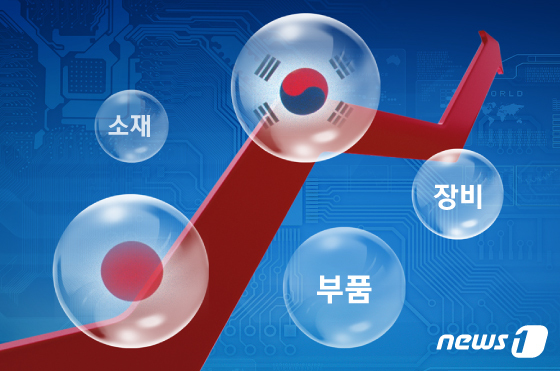 |
| © News1 Designer Kim Il-hwan |
One year and six months have passed since Japan imposed export restrictions on core materials for semiconductors and displays in Korea in 2019. Until now, the government has focused on preparing countermeasures, such as responding to supply chain stabilization and global value chain (GVC) restructuring through public-private cooperation.
On the 24th, the Ministry of Trade, Industry and Energy announced on the 24th, “The wind of change is blowing in the field of small managers, which is the third year of measures to strengthen the competitiveness of small managers.”
First of all, the supply chain of core items of materials, parts and equipment (general manager) has been stably maintained. In particular, it is explained that the domestic production of hydrogen fluoride gas, EUV resist, and polyimide fluoride, which are the three major export items in Japan, has been rapidly expanded through the government’s technology development support and the input of alternative materials by companies.
In the case of hydrogen fluoride gas, SK Materials successfully mass-produced 5N-class high-purity products, and Soulbrain began production by doubling its 12N-class high-purity hydrofluoric acid production facility.
EUV resists have succeeded in diversifying imports from Europe, and polyimide fluoride is being exported to China after Kolon Industries established mass production facilities. SKC is also conducting production input tests after securing its own technology.
In addition to the three major items, the company has diversified its import destinations to the European Union (EU) and the United States, and expanded the average inventory level by item to more than double the previous level. In addition, 23 companies have built new production facilities in Korea, including Hyosung’s carbon fiber production facility and SKC’s new blank mask factory. In addition, efforts such as SK Siltron’s acquisition of the DuPont silicon wafer division in the US were also carried out.
Solidarity and cooperation within the directors’ ecosystem is also on the rise. Immediately after Japan’s export regulations, 23 prototypes were developed out of 25 items supported through an additional supplement in 2019, and 434 patents were filed.
In addition, based on the cooperation of 79 supply and demand companies, support such as research and development (R&D) and investment for 22’cooperation models’ involving various actors such as research institutes is in progress.
In addition, a demand company has opened the mass production line and is in the process of evaluating technology development products, and the government has provided 75 billion won to 262 projects so far.
It is also preparing to enter the global market for the small manager industry beyond overcoming Japan. This month, 22 leading companies specialized in core strategic technologies and possessing global growth capabilities were selected this month, and 100 small and medium-sized companies and 20 startups were already selected last year.
In addition, it created a fund worth 866.2 billion won to invest intensively in small-manager companies, and a total of 3564 billion won was completed, including four small-manager development projects. Through customized support centered on high-tech industries, such as expanding cash incentives and expanding U-turn subsidies, the general manager U-Turn recorded the highest performance ever (18 companies).
In addition, the’Competitiveness Committee for Small Managers’ is operated as a policy control tower to establish policies for small managers and approve cooperation models.The special law for small managers has been revised in 20 years to complete the target, function, scope, method, and system. Modified. In addition, a budget of 2.5 trillion won this year will be operated by establishing a special account for the small manager to secure safe financial resources.
The government is planning to visualize policy effects such as securing the capacity to respond to future minor managers through this year’s minor manager 2.0 strategy.
First, the R&D budget for next-generation technology development such as supply chain core items, big 3 (system semiconductor, future car, biohealth) new industry, carbon neutrality, etc. was set up, and data utilization platform centered on 8 core projects of promising commercial materials. To build.
In addition, the company’s global growth capabilities will be enhanced by additionally selecting the best small managers, Jiangsu, and startups, and strengthening the foundation for entry through open technology cooperation, global network diversification, and small manager investment funds.
In addition, in order to widen the horizon of cooperation between demand-supply companies, a new global cooperation model in which foreign demand companies participate, and a priority purchase by public institutions and introduction of a demand forecast system will create a market.
In addition, this month, a specialized complex for small managers was designated to prepare customized support plans, and high-tech investment zones were also prepared after establishing the legal basis. In order to attract companies’ active investment, financial support of 1.5 trillion won will be provided over five years, including subsidies, and U-turn-specific support will also be expanded.
Industry Minister Sung Yun-mo said, “We are wisely overcoming through the efforts of the people and companies for the past 1 year and 6 months despite repeated supply chain shocks, and our efforts are gradually becoming visible as a result.” I will spare no effort in all policies to make it possible.”
